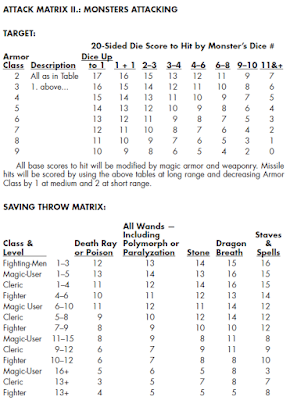Someone recently asked on FB why Call of Cthulhu (and Delta Green) which uses BRP was so un-intuitive, requiring low rolls for skill checks and combat. He thought that d20 was much more intuitive with adding your skill level and bonuses to your die roll to meet or beat a specific target number.
Actually, BRP was more consistent and intuitive than d20 for a very long time.
It's all a matter of history.
 |
| D&D (1974-1976) |
Once, a long long time ago, there was a game called D&D (1974). Armor Classes (AC) went from 9 (no armor) to 2 (plate mail + shield). You had to roll high on a d20 to hit someone in better armor and there was a lookup chart based on your Hit Dice (level) to see if you could hit that armor class. A natural 1 was a miss and a natural 20 was an automatic hit. A 1 HD attacker needed to roll a 17 or better to hit AC 2. There was a lookup chart for saving throws based on level and class vs various dangers such as Poison, Dragon Breath, and Spells. It was a weird thing where you had to roll high to hit lower ACs. The whole system was built to be consistent where you had to roll high to succeed.
 |
| D&D (1974) - Attack and Save Matrix |
 |
| Arduin Grimoire Trilogy (1977-1978) |
In 1977, David Hargrave published The Arduin Grimoire, supplements to D&D. It had critical hit and fumble charts, new monsters, magic spells, and items. If you rolled a 1, you rolled % on the fumble table which ranged from a glancing blow to critically hitting yourself. If you rolled a 20, you rolled % on the critical hit chart which ranged from ruining an eye to decapitation.
 |
| Arduin Grimoire (1977) Critical Hit and Fumble Charts |
 |
| AD&D (1977-1979) |
AD&D came out in 1977-1979 after Arduin Grimore and added their idea of a critical hit (though in the text of DMG they poo-pooed the idea of critical hit location tables or double damage); if you rolled a 20, it was good for 6 consecutive armor classes, then you needed a 21, 22, etc. to hit higher armor classes. It also introduced the idea of THAC0 (To Hit Armor Class 0). Save throws still required rolling high to succeed. But a thief had skills where you had to roll your skill or below to succeed. So you had to look up your level and skill on a table to see what number you had to roll to succeed. Every time your character leveled up, you needed to update your skill %. AC 2 stayed the same (now requires a 18 to be hit by a 1st level attacker) and AC 10 was now "no armor."
 |
| AD&D (1979) DMG - Attack Matrix |
 |
| AD&D (1977) Players Handbook - Thief Table |
 |
| Call of Cthulhu (1981) |
Chaosium (BRP, 1981), publisher of Call of Cthulhu, decided it was easier to just roll your skill or below. It was more intuitive. You roll low to succeed. No special tables were needed (except for the dreaded Resistance Table, a look up table for POW vs POW). BRP is a skill based system, not a level based system. If your skill was 40%, you just needed to roll 40% or less on your percentile dice. If you roll low enough (1/5 of your skill, 1/5 * 40% = roll 8% or less in this example) you do an impale and cause double damage. A natural 01% was a critical success. A natural 100% was a fumble. BRP was consistent overall. Roll low to succeed for combat, save throws, and skills.
 |
| D&D 3.0 (2000) |
Then D&D evolved (D&D 3.0, 2000) and Armor Class became a number you just had to roll or beat to hit your opponent. Still, rolling high to succeed. And your bonuses were based on your level, so you don't need a special table anymore. The AC was now the number you had to roll (with bonuses) in order to hit. Critical Hits were added. If you rolled a natural 20, there's a chance of a critical hit if you roll again and score a hit, you do double damage (so much for poo-pooing critical hits). Saving Throws and Skill Checks switched to DC (difficulty class) where you had to roll the number or higher to succeed. So, now D&D was consistent for combat, save throws, and skill checks. Roll high to succeed.
 |
| D&D 5.0 (2014) |
D&D 5.0 (2014), Critical hits were now just your natural 20 causing double damage. Also some skills (assassinate) cause critical hits and some magic weapons generate critical hits on lower numbers such as a natural 19 and 20. So, D&D went full circle back to a natural 20 being a critical hit.
Pop Quiz: When is AC 2 better than AC 10? When is AC 28 better than AC 10?
Answer: Depends on your version of D&D. 😊










No comments:
Post a Comment